Pythons and anacondas are often confused with one another, and it’s not hard to see why that happens. They are both very long, powerful snakes that use ambushing and constriction to kill their prey and have no venom. However, they are very different reptiles when you look a little closer. Still, we can’t help but wonder which of these snakes would win in a python vs anaconda battle.
Given that the anaconda lives in South America and pythons have a natural habitat in Asia, Africa, and Australia, it’s unlikely they have ever met in the wild.
Yet, with the way that pythons are being introduced all over the world, especially the Burmese python, it might be a matter of time before this showdown happens in real life.
To make this a fair comparison, we’re going to use information from the reticulated python and a green anaconda, the best representatives from the pythons and anacondas. Take a look at which one of these creatures stands the best chance of surviving an encounter with the other.
Comparing a Python and Anaconda
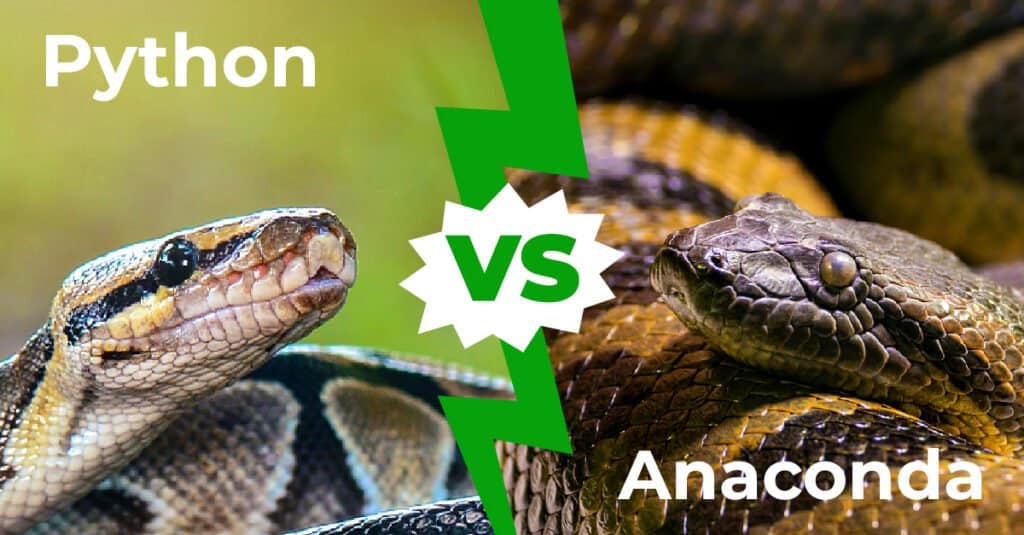
| Python | Anaconda | |
| Size | Weight: 200lbs Length: 10-28 feet | Weight: 250lbs -550lbs Length: 17-22 feet Diameter: 12 inches |
| Speed and Movement Type | – 1mph – 2-3 mph in water (some species) – Slithers on the ground and in trees | -5 mph on land -10 mph in the water |
| Squeeze Power and Teeth | – 14 PSI crushing power (measured on a 5.5-meter python) – 100 sharp, rear-pointing teeth that help them eat. | – 90 PSI crush power – Roughly 100 rear-facing teeth to help latch on prey. |
| Senses | – Use Jacobson’s organ to smell very well, darting their tongue out to gain information – Poor typical eyesight but capable of “seeing” heat. – Can hear low frequencies. | – Pit organs help identify heat from prey – Anacondas pick up vibrations from other creatures. – Uses Jacobson’s organ to smell and process chemicals. |
| Defenses | – Large size – Hides well – Camouflage makes it hard to see | – Their eyes on their head allow them to skim the surface of the water. – Swims in water – Large size – Camouflage |
| Offensive Capabilities | – Painful, non-venomous bite – Bite is often not severe enough to cause fatality – Powerful constriction that deals internal damage and suffocates | – Powerful bite for grasping – Immensely powerful constriction that kills by stopping the prey’s heart while causing internal damage. |
| Predatory Behavior | – Ambush hunter – Active at night – Bites and holds prey and then wraps and constricts them | – Ambush prey in and out of water – Bites and holds prey while coiling around them and constricting. |
What Are the Key Differences Between Python and Anaconda?
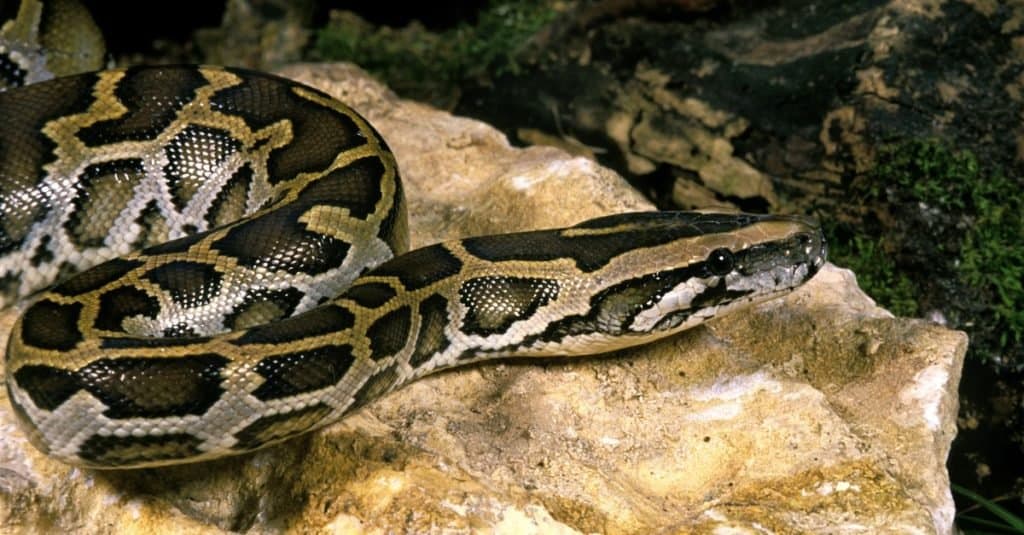
Pythons are longer and lighter than anacondas, but they both use ambushes to kill prey.
©slowmotiongli/Shutterstock.com
The anaconda is shorter, thicker, and heavier than the python, but they are both ambush predators that constrict their enemies. There are other more subtle differences, such as how the anaconda’s eye placement is slightly higher on its head to allow it to skim the water while swimming. The primary difference between the two is that the anaconda is much stronger. In fact, that key difference will be a deciding factor in the fight.
The Key Factors in a Fight Between a Python and an Anaconda

A python vs anaconda fight will be settled by their weight, length, and crushing power.
©iStock.com/Schumaher
Determining which of these snakes would come away victorious from a fight requires a fair amount of insight into each creature. We have determined that seven points of data are vital to choosing a victor in this case.
We have broken these characteristics down into two data subsets: physical features and their application of those features in combat. Consider how the python and anaconda perform in each.
Behavior
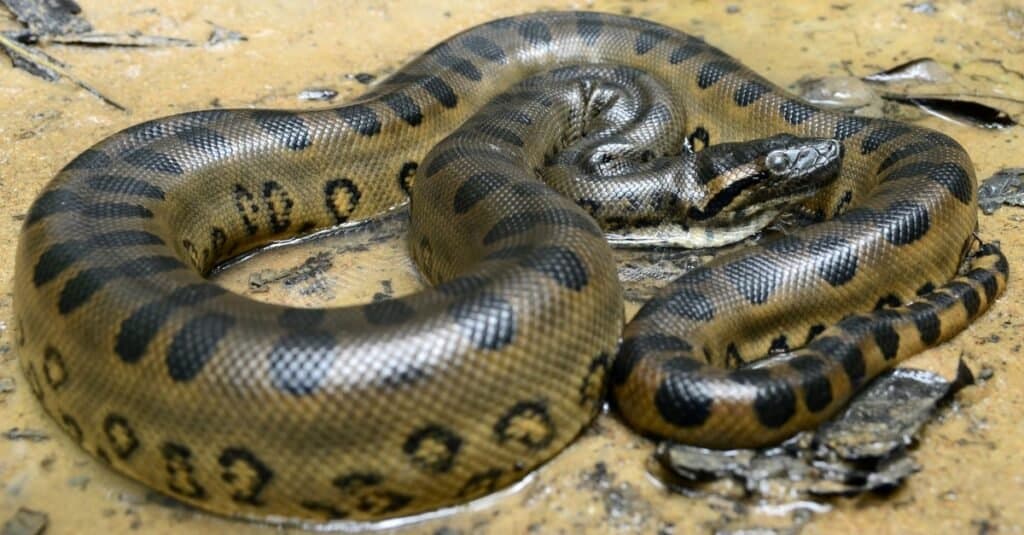
A Green anaconda (Eunectes murinus), which is especially partial to flooded grassland.
©Patrick K. Campbell/Shutterstock.com
Pythons and anacondas are two of the largest and most powerful snakes in the world. Both species are apex predators and can grow to be over 20 feet long and weigh hundreds of pounds. Despite their similar size and appearance, there are some significant differences in their behavior and habitat.
Pythons are found in a variety of habitats across the world, including Africa, Asia, and Australia. They are constrictors, meaning they wrap their powerful bodies around their prey and squeeze until they suffocate. Pythons are ambush hunters, lying in wait for their prey to come to them rather than actively hunting them down. They are also known to be excellent climbers, able to climb trees and bushes in search of prey.
Anacondas, on the other hand, are primarily found in the swamps and marshes of South America. They are also constrictors, but they are known for their ability to take down much larger prey than pythons. Anacondas are active hunters, moving through the water in search of their next meal. They are excellent swimmers and can hold their breath for up to 10 minutes while hunting underwater.
Physical Features
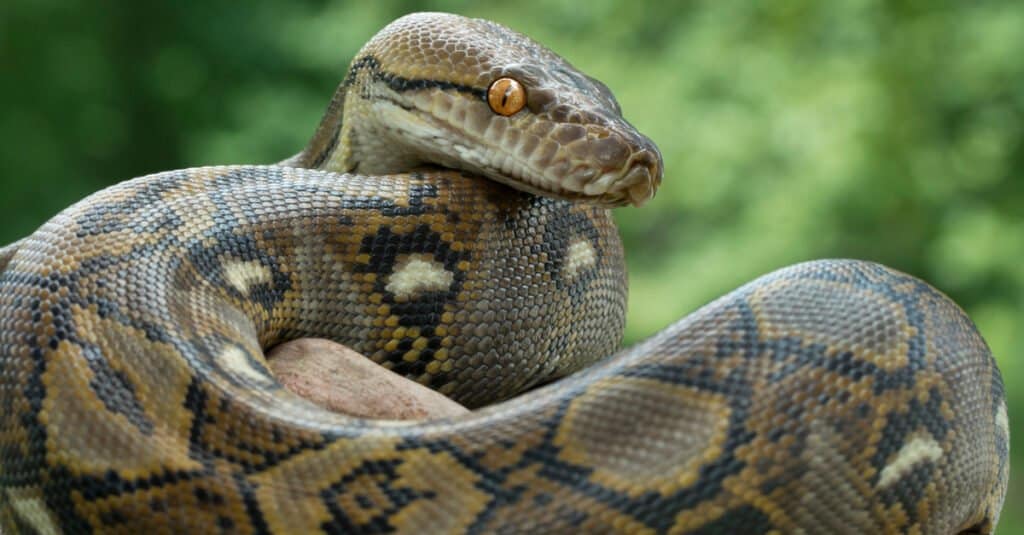
A reticulated python is the longest
snake in the world
.
©Mark_Kostich/Shutterstock.com
The physical features of two creatures fighting against one another often determine the winner. Take a look at several measurements of the python and anaconda and see who has the physical advantage in a fight.
Python vs Anaconda: Size

A python can weigh up to 200 lbs and grow up to 28 feet while an anaconda can be 22 feet long and 500 lbs!
©zaferkizilkaya/Shutterstock.com
The largest species of python can weigh upwards of 200 lbs and have a length of up to 28 feet or more. That’s a tremendous creature. An anaconda is shorter than a python, growing up to 22 feet but weighing in at up to 550 lbs.
The anaconda is a huge reptile that has a diameter of up to 12 inches; that’s massive!
The python is longer, but the anaconda is thicker and much heavier, so it gets the advantage.
Python vs Anaconda: Speed and Movement
Snakes are not known for their speed, and they often rely on ambushes to catch prey. The python can hit reach a maximum speed on land of 1mph as it slithers along, and it can maintain about that speed in the water. Some pythons swim, like the reticulated python, but others do not swim much.
The anaconda is slightly faster on land, racing along at 5mph on land. In the water, where they spend most of their time, they can swim 10 mph.
The anaconda gets the advantage in terms of speed and movement.
Python vs Anaconda: Squeeze Power and Biting
Both the reticulated python and the green anaconda are constrictors. They use similar means to attack and kill prey by squeezing them to death. The python’s squeezing force is about 14 PSI, and that is enough to kill human beings. They bite with rear-facing teeth to help them get prey into their bodies.
Anacondas have a squeezing force that measures 90 PSI, putting a lot more pressure on their foes than pythons. They can easily take down large mammals and fish. Their biting is very similar to a python’s.
The anaconda gets the edge for power and biting.
Python vs Anaconda: Senses
The python’s senses are rather good, capable of tracking heat and using specialized organs to process chemical information and locate prey. The anaconda has almost the same exact same set of sensory organs and capabilities.
The python and anaconda tie for senses.
Python vs Anaconda: Physical Defenses
The python can hide in water, in trees, and in rocks. Using its camouflage and size, it’s able to avoid being preyed upon by others. The anaconda has similar physical defenses with one caveat: its eyes are on the top of its head, allowing it to be more vigilant while in the water.
The anaconda gets a slight edge in the category of physical defenses.
Combat Skills
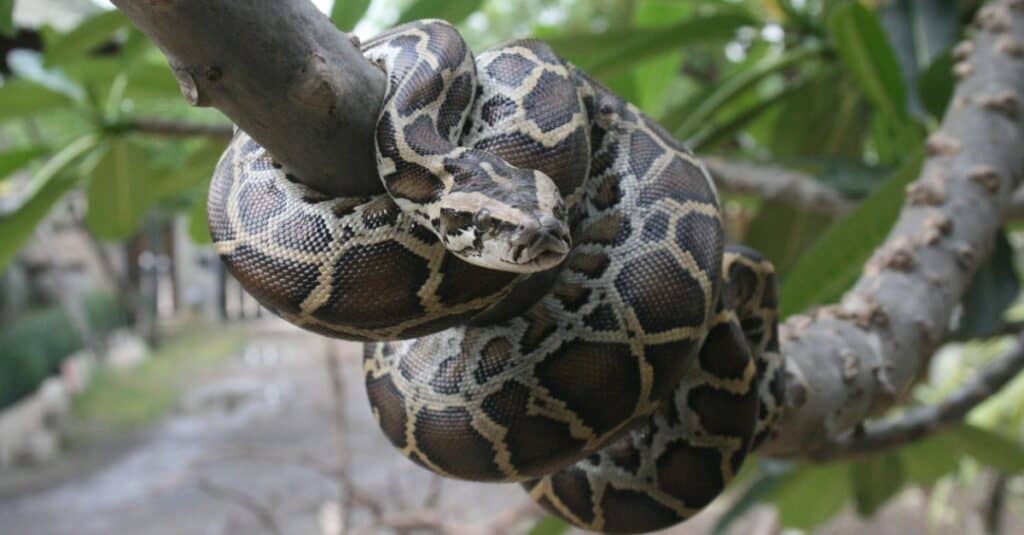
Pythons are ambush predators, just like anacondas.
©iStock.com/Lunatic_67
Physical traits are important to examine between any two fighters, but the skills a creature has at killing another can tilt the table in their favor. Take a look at how the python and anaconda hunt and kill prey and see who is better at their grisly task.
Python vs Anaconda: Offensive Capabilities
The python is built to capture and eat prey. They have nearly 100 teeth that deliver a powerful bite, but it’s not used to kill the enemy. It’s used to latch onto them and begin wrapping up their foe and squeezing them to death.
The anaconda does the exact same thing, but it has more crush force to put an end to the fight.
The offensive capabilities of these two creatures are similar, but the anaconda is much stronger and gets the advantage.
Python vs Anaconda: Predatory Behaviors
The python is an amazing ambush predator that hides in trees, near water, and in other areas to find prey. They are very active at night and highly capable of taking down large prey several times their size, like deer.
The anaconda is very similar in its predatory behaviors, down to the way it ambushes prey. It often attacks prey from the water.
For predatory behaviors, the snakes are tied.
Who Would Win in a Fight Between Python and Anaconda?

An anaconda would win in a fight against a python.
©Patrick K. Campbell/Shutterstock.com
An anaconda would win in a fight against a python. These two creatures are so similar in every facet except for length, thickness, and weight, and those are the ones we have to use to determine who would win if they faced off.
Outside of an ambush opportunity by one or the other, the most likely outcome is that the anaconda and python engage in a direct fight with each other, snapping bites at each other in hopes of grasping the other.
The only problem is that the anaconda can be up to one foot in diameter, and it will be much harder for the python to bite and constrict something with that large frame.
The more likely result is that the anaconda gets an initial bite, and the python will be helpless to get out of the anaconda’s twisting grasp, or the python will be worn down by countering the immense weight and heft of the anaconda and eventually run out of steam.
Either way, the anaconda wins this fight.
Other Animals That Could Take Down a Python: Python vs Alligator
Python vs Alligator? Who Would Win? Overall, we’ve determined that an alligator would prevail against a python in a fight. It should be noted that this assumes the alligator is mature. When fully grown, alligators have the strength to fend off or even kill a python. To kill an alligator, a python would need to be significantly longer and stronger than the animal, something that does happen in the wild but is rare.
Most likely, a typical adult alligator would be big enough to take down a typical adult python. The conflict may start in a number of ways, but it would probably begin close to the water. When anything sneaks into their water to ambush them, alligators adore it.
Despite having keen senses, the python wouldn’t pick up an alligator with cold blood that was submerged for the majority of its body.
The photo featured at the top of this post is © Mark_Kostich/Shutterstock.com
Discover the "Monster" Snake 5X Bigger than an Anaconda
Every day A-Z Animals sends out some of the most incredible facts in the world from our free newsletter. Want to discover the 10 most beautiful snakes in the world, a "snake island" where you're never more than 3 feet from danger, or a "monster" snake 5X larger than an anaconda? Then sign up right now and you'll start receiving our daily newsletter absolutely free.
Thank you for reading! Have some feedback for us? Contact the AZ Animals editorial team.






